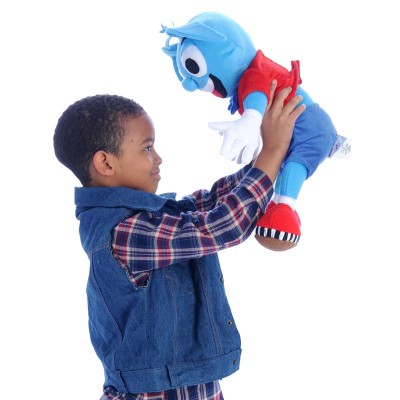At the heart of every human being is the ability to communicate. Though a typical speech therapy session may use cards and oral motor tools, adding sensory friendly tools can dramatically improve the interaction. For example, using a toy to engage a child can change a 2D experience into a 3D hands-on experience. Take a look at a few "talk tools" that encourage speaking and communication.
Heavy Herbert:
He's quite unique and there's so much you can "say" about him. Just talking about his features alone can take up an entire therapy session. But Herbert is awesome because he's friendly, soft and best of all weighted. Kids love to carry him around and, well, talk about him. Where is Herbert now? What does Herbert like to do?
Discovery Putty:
Nothing gets those lips moving like putty. There's a connection between heavy handwork and communication skills. Putty falls into the "art" category where the mind can relax while the hands are busy at work. Using putty with fun hidden pieces can have your kids pining for their therapy sessions. And, if you listen, you might catch a glimpse of how your child loves to play.
Web Tower Swing:
When my kids were younger and I wanted to hear about their day at school, we'd hit the swing set. On a swing, kids will sing, whistle, hum and maybe even tell a story. A swing gives your kids a heavy workout and your child may just give you a few giggles too.
Air-Lite Ball Pit:
This is a great tool for exploration and sensory integration, and you can use it to discuss color, size and naming objects. Encourage your children to reach into the ball pit. What did you find? You can also sit and talk in the pit or read a book and look at pictures. It's a great spot for conversing or just playing.
Scarves:
Eye hand coordination can do wonders for calming, focus and concentration skills, but it can also be a great pre-cursor to engaging kids in a conversation. Toss up one, two or three scarves and play catch. Hide them around the room and pick them up. Now your child is ready for the therapy session.
Mirror:
At the core of language are facial features and expressions. Use a mirror to find the mouth, tongue, cheeks and jaw. Try making faces and mimicking sounds. Take a dry erase marker and draw facial expressions or words directly onto the mirror to copy, say or mimic.
Stretch Dino Wrap:
Using costumes to encourage communication, speech and language skills is beneficial, and helps to engage children in their therapy sessions. Who are you? A dinosaur? What kind of dinosaur? Where do you live? What do you like to eat? How loud can you roar?
As you can see, there are many ways to go beyond two-dimensional images for speech therapy. Step out of the box and let your creativity and imagination bring communications to life -- at school, home or clinic.
Use these tools to support social skills and emotional development.


























Comments